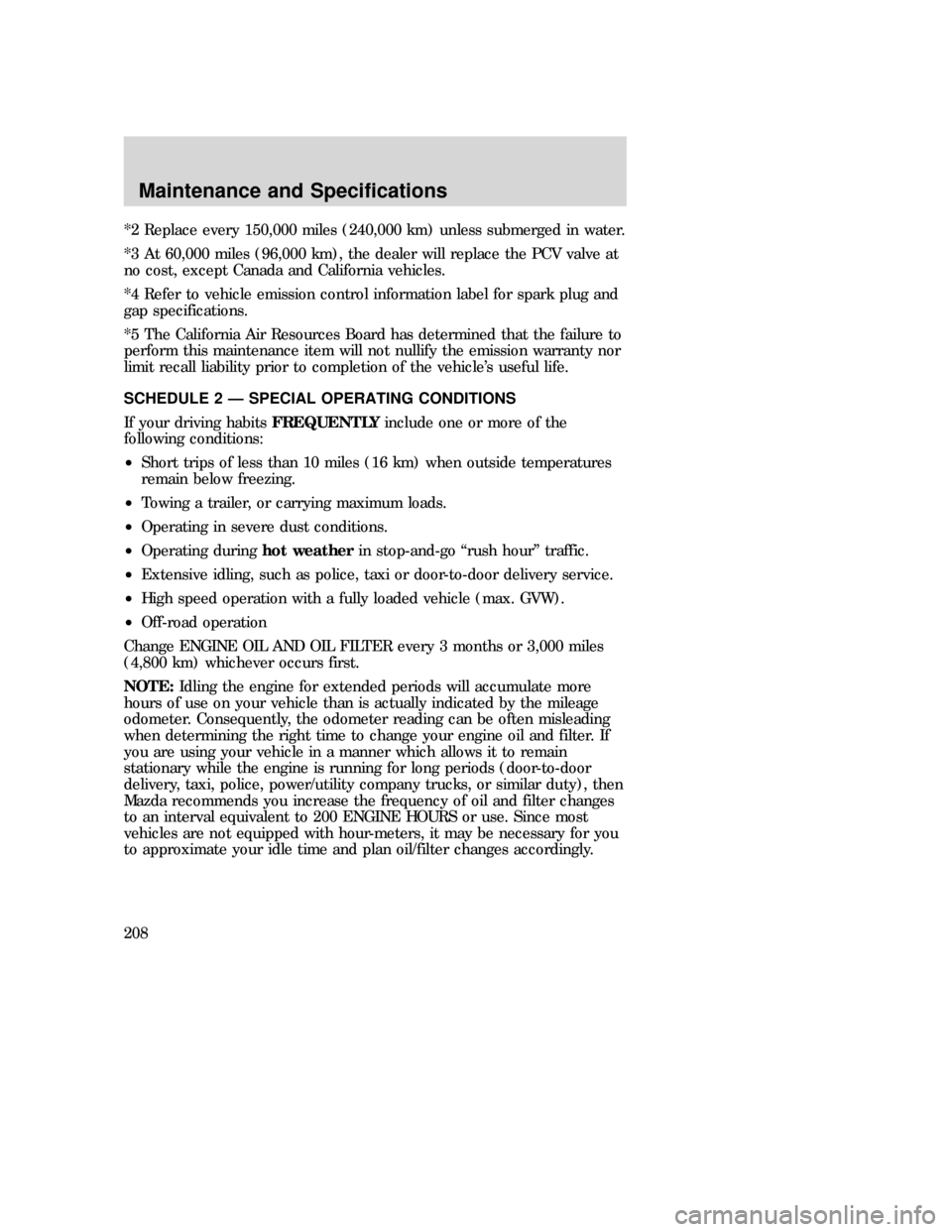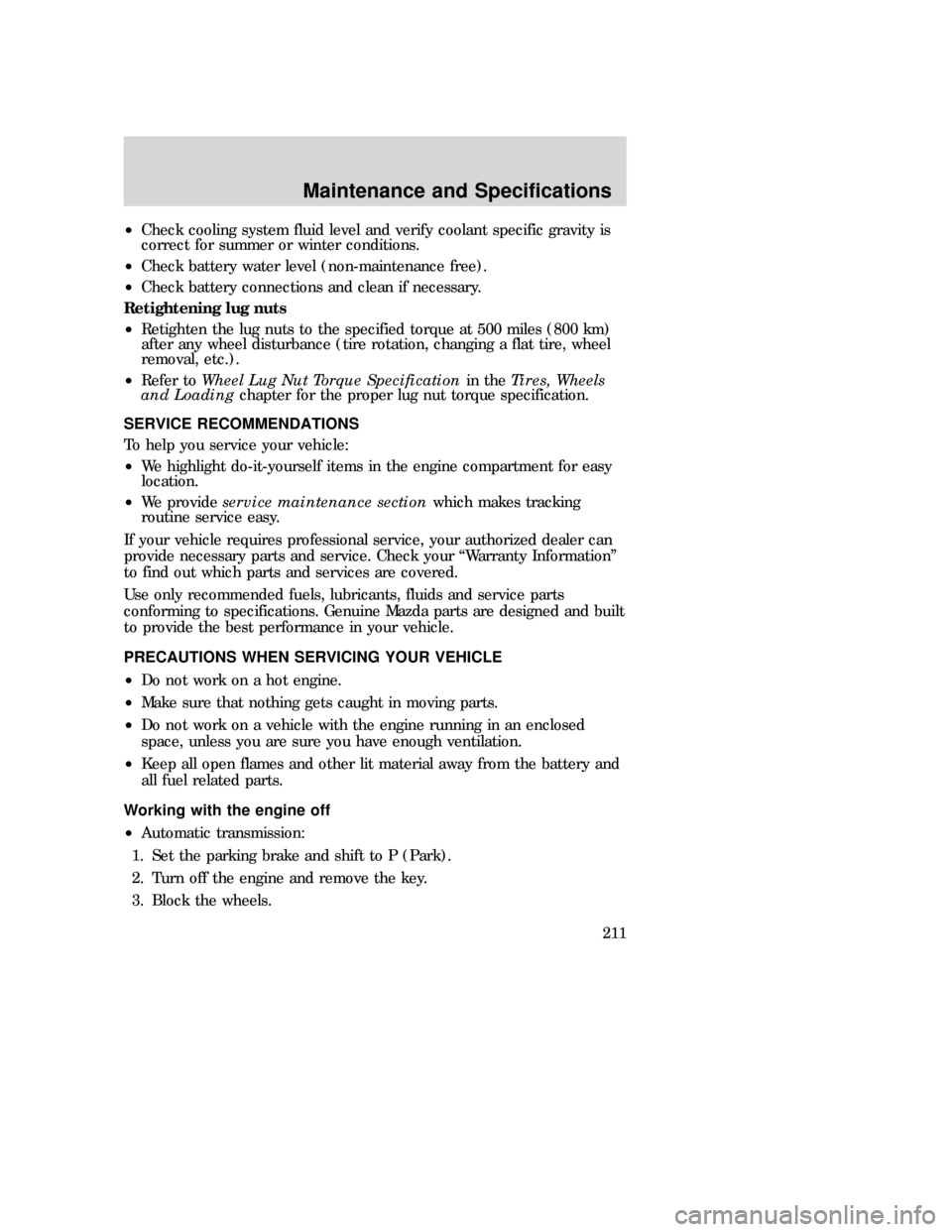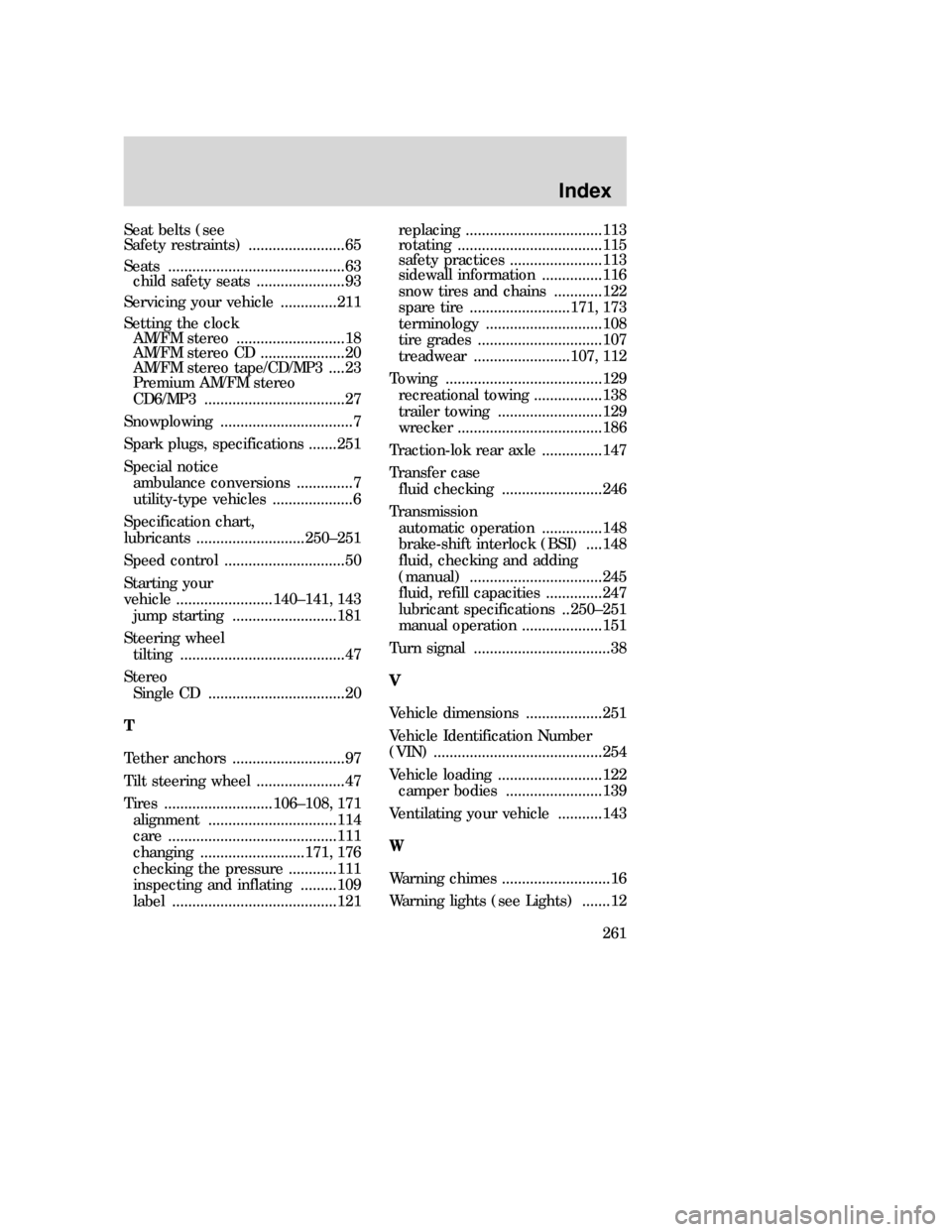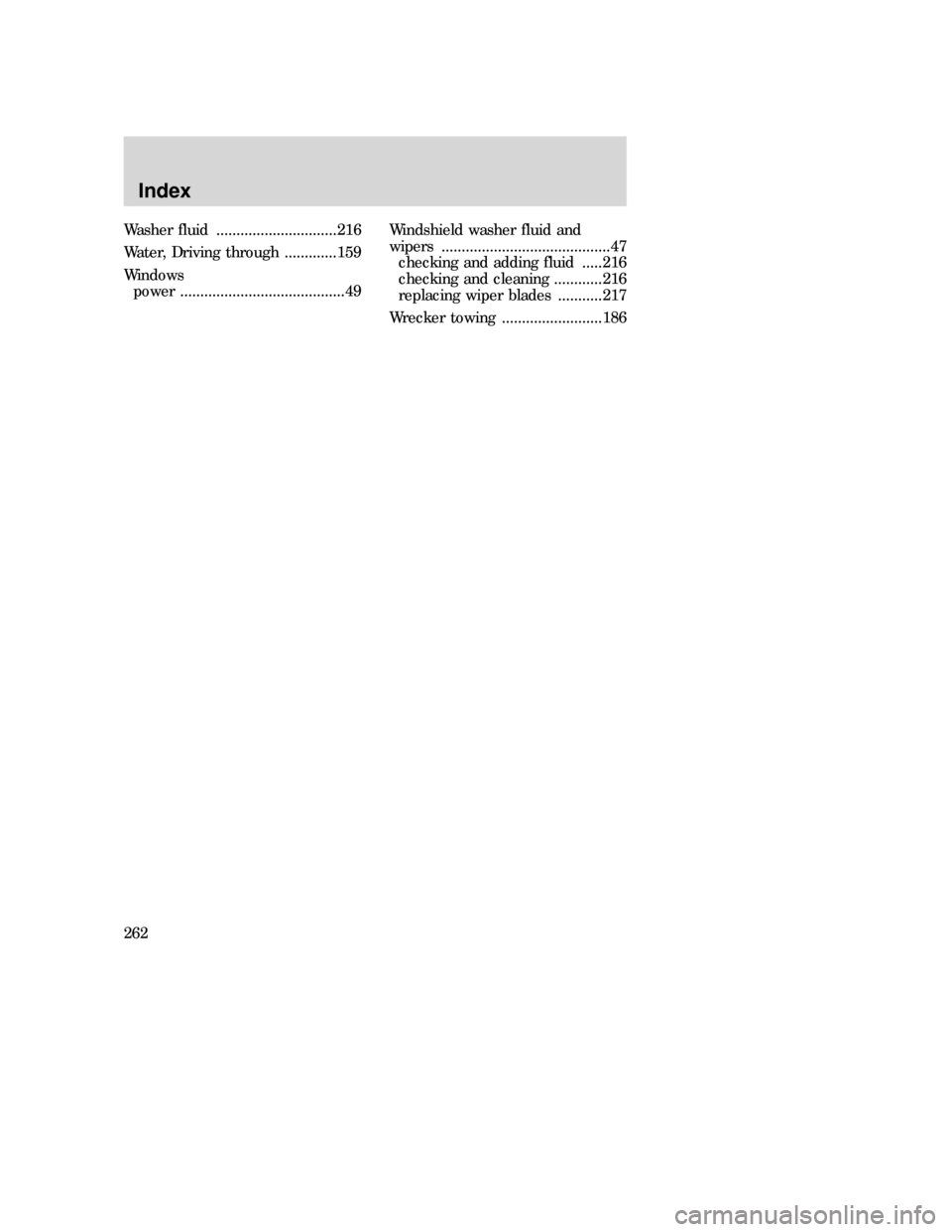tow MAZDA MODEL B-SERIES 2006 (in English) Workshop Manual
[x] Cancel search | Manufacturer: MAZDA, Model Year: 2006, Model line: MODEL B-SERIES, Model: MAZDA MODEL B-SERIES 2006Pages: 262, PDF Size: 2.47 MB
Page 207 of 262

Maintenance
ItemMaintenance Interval (Number of months or Miles (km),
whichever comes first)
Months 52 56 60 64 68 72 76 80 84 88 92 96
x 1000 miles 65 70 75 80 85 90 95 100 105 110 115 120
(x 1000 km) (104) (112) (121) (128) (136) (144) (152) (160) (168) (176) (184) (192)
Caliper slide rails L L L L
Drum brake system,
lines and hosesIIII
Exhaust system for
leaks, damage, loosenessII
Manual transmission
fluidR
Automatic
transmission
fluid*2 I I
Exhaust system
shielding (for trapped
material)II
Propeller shaft U-joints
(if equipped with
grease fittings)LLLLLL
Parking brake system
(for damage and
operation)IIII
Ball joints (4x2) I/L I/L I/L I/L
Transfer case fluid
(4x4)Replace every 150,000 miles (240,000 km)
Rear axle lubricant Does not require replacement unless rear axle submerged in
water
Accessory drive belts I
Fuel filter *5 R R
Steering linkage, ball
joints, suspension and
driveshaftIIII
*1 The wheel lug nuts must be retightened to the proper specifications
at 500 miles (800 km) of new vehicle operation, at any wheel change, or
at any other time the wheel lug nuts have been loosened. Refer toWheel
Lug Nut Torque Specificationin theTires, Wheels and Loading
chapter for the proper lug nut torque specification.
2006 B-Series(mbs)
Owners Guide (post-2002-fmt)
Canadian_French(fr_can)
Maintenance and Specifications
207
Page 208 of 262

*2 Replace every 150,000 miles (240,000 km) unless submerged in water.
*3 At 60,000 miles (96,000 km), the dealer will replace the PCV valve at
no cost, except Canada and California vehicles.
*4 Refer to vehicle emission control information label for spark plug and
gap specifications.
*5 The California Air Resources Board has determined that the failure to
perform this maintenance item will not nullify the emission warranty nor
limit recall liability prior to completion of the vehicle’s useful life.
SCHEDULE 2 — SPECIAL OPERATING CONDITIONS
If your driving habitsFREQUENTLYinclude one or more of the
following conditions:
•Short trips of less than 10 miles (16 km) when outside temperatures
remain below freezing.
•Towing a trailer, or carrying maximum loads.
•Operating in severe dust conditions.
•Operating duringhot weatherin stop-and-go “rush hour” traffic.
•Extensive idling, such as police, taxi or door-to-door delivery service.
•High speed operation with a fully loaded vehicle (max. GVW).
•Off-road operation
Change ENGINE OIL AND OIL FILTER every 3 months or 3,000 miles
(4,800 km) whichever occurs first.
NOTE:Idling the engine for extended periods will accumulate more
hours of use on your vehicle than is actually indicated by the mileage
odometer. Consequently, the odometer reading can be often misleading
when determining the right time to change your engine oil and filter. If
you are using your vehicle in a manner which allows it to remain
stationary while the engine is running for long periods (door-to-door
delivery, taxi, police, power/utility company trucks, or similar duty), then
Mazda recommends you increase the frequency of oil and filter changes
to an interval equivalent to 200 ENGINE HOURS or use. Since most
vehicles are not equipped with hour-meters, it may be necessary for you
to approximate your idle time and plan oil/filter changes accordingly.
2006 B-Series(mbs)
Owners Guide (post-2002-fmt)
Canadian_French(fr_can)
Maintenance and Specifications
208
Page 209 of 262

Special Operating
Conditions
Replace Engine Oil and Filter
Inspect Brake System
Replace Fuel Filter
Change Automatic Transmission Fluid
Replace Spark Plugs
Replace Engine Air Filter
Change Manual Transmission Fluid
Inspect and Lubricate U-Joints
Lubricate Front Wheel Bearing (4x2)
Change Transfer Case Fluid (4x4)
Suggested
Maintenance Interval3,000
miles or
3 months5,000
miles15,000
miles30,000
miles60,000
milesAs
requiredAs
requiredAs
required30,000
miles60,000
miles
Towing a trailer or
using a camper or
car top carrierXXXX
Extensive idling or
low-speed driving
for long distances
as in heavy
commercial use
such as delivery,
taxi or patrol carX XXXX XX
Operating in dusty
conditions such as
unpaved or dusty
roadsXXX X
Off road operation X X X
For specific recommendations see your authorized Mazda dealer or
qualified service professional.
OWNER MAINTENANCE
Owner Maintenance Schedule
The owner or a qualified service technician should make these vehicle
inspections at the indicated intervals to ensure safe and dependable
operation.
Bring any problem to the attention of an Authorized Mazda Dealer or
qualified service technician as soon as possible.
2006 B-Series(mbs)
Owners Guide (post-2002-fmt)
Canadian_French(fr_can)
Maintenance and Specifications
209
Page 211 of 262

•Check cooling system fluid level and verify coolant specific gravity is
correct for summer or winter conditions.
•Check battery water level (non-maintenance free).
•Check battery connections and clean if necessary.
Retightening lug nuts
•Retighten the lug nuts to the specified torque at 500 miles (800 km)
after any wheel disturbance (tire rotation, changing a flat tire, wheel
removal, etc.).
•Refer toWheel Lug Nut Torque Specificationin theTires, Wheels
and Loadingchapter for the proper lug nut torque specification.
SERVICE RECOMMENDATIONS
To help you service your vehicle:
•We highlight do-it-yourself items in the engine compartment for easy
location.
•We provideservice maintenance sectionwhich makes tracking
routine service easy.
If your vehicle requires professional service, your authorized dealer can
provide necessary parts and service. Check your “Warranty Information”
to find out which parts and services are covered.
Use only recommended fuels, lubricants, fluids and service parts
conforming to specifications. Genuine Mazda parts are designed and built
to provide the best performance in your vehicle.
PRECAUTIONS WHEN SERVICING YOUR VEHICLE
•Do not work on a hot engine.
•Make sure that nothing gets caught in moving parts.
•Do not work on a vehicle with the engine running in an enclosed
space, unless you are sure you have enough ventilation.
•Keep all open flames and other lit material away from the battery and
all fuel related parts.
Working with the engine off
•Automatic transmission:
1. Set the parking brake and shift to P (Park).
2. Turn off the engine and remove the key.
3. Block the wheels.
2006 B-Series(mbs)
Owners Guide (post-2002-fmt)
Canadian_French(fr_can)
Maintenance and Specifications
211
Page 217 of 262

Changing the wiper blades
1. Pull the wiper arm away from
the vehicle. Turn the blade at an
angle from the wiper arm. Push
the lock pin manually to release
the blade and pull the wiper
blade down toward the
windshield to remove it from
the arm.
2. Attach the new wiper to the
wiper arm and press it into
place until a click is heard.
Replace wiper blades at least once per year for optimum performance.
Poor wiper quality can be improved by cleaning the wiper blades and the
windshield, refer toWindows and wiper bladesin theCleaning
chapter.
To prolong the life of the wiper blades, it is highly recommended to
scrape off the ice on the windshield before turning on the wipers. The
layer of ice has many sharp edges and can damage the micro edge of the
wiper rubber element.
ENGINE OIL
Checking the engine oil
Refer to theservice maintenance sectionfor the appropriate intervals
for checking the engine oil.
1. Make sure the vehicle is on level ground.
2. Turn the engine off and wait a few minutes for the oil to drain into
the oil pan.
3. Set the parking brake and ensure the gearshift is securely latched in
P (Park) (automatic transmission) or 1 (First) (manual
transmission).
4. Open the hood. Protect yourself from engine heat.
2006 B-Series(mbs)
Owners Guide (post-2002-fmt)
Canadian_French(fr_can)
Maintenance and Specifications
217
Page 235 of 262

performance and emission control system protection for your vehicle.
Gasolines that meet the World-wide Fuel Charter should be used when
available. Ask your fuel supplier about gasolines that meet the
World-wide Fuel Charter.
Running out of fuel
Avoid running out of fuel because this situation may have an adverse
effect on powertrain components.
If you have run out of fuel:
•You may need to cycle the ignition from off to on several times after
refueling, to allow the fuel system to pump the fuel from the tank to
the engine.
•The
indicator may come on. For more information on the “Check
Engine” or the “Service engine soon” indicator, refer toWarning
lights and chimesin theInstrument Clusterchapter.
ESSENTIALS OF GOOD FUEL ECONOMY
Measuring techniques
Your best source of information about actual fuel economy is you, the
driver. You must gather information as accurately and consistently as
possible. Fuel expense, frequency of fillups or fuel gauge readings are
NOT accurate as a measure of fuel economy. We do not recommend
taking fuel economy measurements during the first 1,000 miles (1,600
km) of driving (engine break-in period). You will get a more accurate
measurement after 2,000 miles-3,000 miles (3,000 km–5,000 km).
Filling the tank
The advertised fuel capacity of the fuel tank on your vehicle is equal to
the rated refill capacity of the fuel tank as listed in theRefill capacities
section of this chapter.
The advertised capacity is the amount of the indicated capacity and the
empty reserve combined. Indicated capacity is the difference in the
amount of fuel in a full tank and a tank when the fuel gauge indicates
empty. Empty reserve is the small amount of fuel remaining in the fuel
tank after the fuel gauge indicates empty.
The amount of usable fuel in the empty reserve varies and should
not be relied upon to increase driving range. When refueling your
vehicle after the fuel gauge indicates empty, you might not be
able to refuel the full amount of the advertised capacity of the
fuel tank due to the empty reserve still present in the tank.
2006 B-Series(mbs)
Owners Guide (post-2002-fmt)
Canadian_French(fr_can)
Maintenance and Specifications
235
Page 237 of 262

Habits
•Smooth, moderate operation can yield up to 10% savings in fuel.
•Steady speeds without stopping will usually give the best fuel
economy.
•Idling for long periods of time (greater than one minute) may waste
fuel.
•Anticipate stopping; slowing down may eliminate the need to stop.
•Sudden or hard accelerations may reduce fuel economy.
•Slow down gradually.
•Driving at reasonable speeds (traveling at 55 mph [88 km/h] uses 15%
less fuel than traveling at 65 mph [105 km/h]).
•Revving the engine before turning it off may reduce fuel economy.
•Using the air conditioner or defroster may reduce fuel economy.
•You may want to turn off the speed control in hilly terrain if
unnecessary shifting between fourth and fifth gear occurs.
Unnecessary shifting of this type could result in reduced fuel
economy.
•Warming up a vehicle on cold mornings is not required and may
reduce fuel economy.
•Resting your foot on the brake pedal while driving may reduce fuel
economy.
•Combine errands and minimize stop-and-go driving.
Maintenance
•Keep tires properly inflated and use only recommended size.
•Operating a vehicle with the wheels out of alignment will reduce fuel
economy.
•Use recommended engine oil. Refer torefill capacitiesin this chapter.
•Perform all regularly scheduled maintenance items. Follow the
recommended maintenance schedule and owner maintenance checks
found inservice maintenance section.
Conditions
•Heavily loading a vehicle or towing a trailer may reduce fuel economy
at any speed.
•Carrying unnecessary weight may reduce fuel economy (approximately
1 mpg [0.4 km/L] is lost for every 400 lb [180 kg] of weight carried).
2006 B-Series(mbs)
Owners Guide (post-2002-fmt)
Canadian_French(fr_can)
Maintenance and Specifications
237
Page 261 of 262

Seat belts (see
Safety restraints) ........................65
Seats ............................................63
child safety seats ......................93
Servicing your vehicle ..............211
Setting the clock
AM/FM stereo ...........................18
AM/FM stereo CD .....................20
AM/FM stereo tape/CD/MP3 ....23
Premium AM/FM stereo
CD6/MP3 ...................................27
Snowplowing .................................7
Spark plugs, specifications .......251
Special notice
ambulance conversions ..............7
utility-type vehicles ....................6
Specification chart,
lubricants ...........................250–251
Speed control ..............................50
Starting your
vehicle ........................140–141, 143
jump starting ..........................181
Steering wheel
tilting .........................................47
Stereo
Single CD ..................................20
T
Tether anchors ............................97
Tilt steering wheel ......................47
Tires ...........................106–108, 171
alignment ................................114
care ..........................................111
changing ..........................171, 176
checking the pressure ............111
inspecting and inflating .........109
label .........................................121replacing ..................................113
rotating ....................................115
safety practices .......................113
sidewall information ...............116
snow tires and chains ............122
spare tire .........................171, 173
terminology .............................108
tire grades ...............................107
treadwear ........................107, 112
Towing .......................................129
recreational towing .................138
trailer towing ..........................129
wrecker ....................................186
Traction-lok rear axle ...............147
Transfer case
fluid checking .........................246
Transmission
automatic operation ...............148
brake-shift interlock (BSI) ....148
fluid, checking and adding
(manual) .................................245
fluid, refill capacities ..............247
lubricant specifications ..250–251
manual operation ....................151
Turn signal ..................................38
V
Vehicle dimensions ...................251
Vehicle Identification Number
(VIN) ..........................................254
Vehicle loading ..........................122
camper bodies ........................139
Ventilating your vehicle ...........143
W
Warning chimes ...........................16
Warning lights (see Lights) .......12
2006 B-Series(mbs)
Owners Guide (post-2002-fmt)
Canadian_French(fr_can)
Index
261
Page 262 of 262

Washer fluid ..............................216
Water, Driving through .............159
Windows
power .........................................49Windshield washer fluid and
wipers ..........................................47
checking and adding fluid .....216
checking and cleaning ............216
replacing wiper blades ...........217
Wrecker towing .........................186
2006 B-Series(mbs)
Owners Guide (post-2002-fmt)
Canadian_French(fr_can)
Index
262